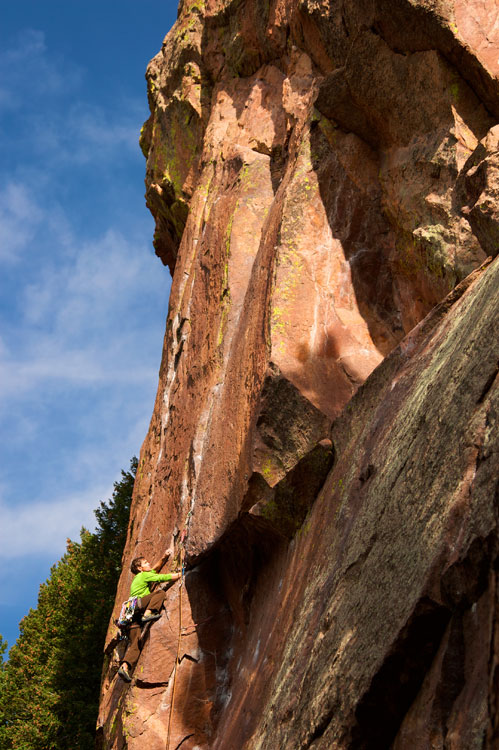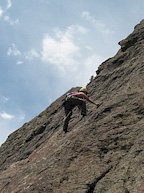Climbers love Boulder. Whether you're a trad climber seeking the airy lines of Eldo, a sport climber looking for granite in the canyon, or a boulderer wanting to tackle some Flagstaff Mountain classics, Boulder will keep you happy.
In addition to the options in Boulder, destinations such as Lumpy Ridge, Shelf Road, Garden of the Gods, and Rifle are just a few hours away. However, there is enough climbing within Boulder itself to keep most people busy for years. Below we've listed some local highlights.
Eldo is a world-reknown site for trad climbing. Many folks visit Boulder simply to sample Eldo's 700+ routes.
 The popular climbs see a lot of traffic. On weekends in particular, there will often be a line to hop on the multi-pitches. Having said that, below are some classics.
The popular climbs see a lot of traffic. On weekends in particular, there will often be a line to hop on the multi-pitches. Having said that, below are some classics.
The Bastille Crack (5.7, 5 pitches) on the north face of the Bastille is one of Boulder's most sought-out moderates. Eldo isn't primarily a crack-climber's spot; however, the Bastille will let you jam for hundreds of feet. Get there early to beat the crowds.
Rewritten (5.7, 6 pitches) on the upper Redgarden Wall is an exposed, popular 5.7. Can be linked with the Green Spur (5.9, 2 pitches) for an alternative start. Note that P1 of Rewritten is notoriously difficult to protect.
Wind Ridge (5.8, 4 pitches), on the Wind Tower, is a pleasure. Can become quite crowded due to its popularity. While there, also try Calypso (5.7, 3 pitches).
The Yellow Spur (5.9, 7 pitches) on the Redgarden Wall is another classic. Exposed, balancy, colorful — Eldo at its best. Enjoy the roofs, scary traverses, and well-placed fixed pins. Starts tough, with an original 5.10 variation.
The Naked Edge (5.11b, 6 pitches), also on Redgarden, draws climbers from around the world. The climb begins with a P1 finger-crack. Run-out placements on the next two pitches prepare you for a tough P4 and a crux P5. Enjoy the great views on a pleasant P6.
Hundreds of sport lines on solid granite make Boulder Canyon a great site for sport climbing.
Most climbs are single-pitch, and require no more than 12 draws and a 60 meter rope. Anchors are generally bolted, and often include rap rings. Local ethics permit lowering through the rings for the final climber; however, please use your own draws to top-rope.
Every climber has his or her favorite spots in the canyon. However, you might want to begin with three tiers of Avalon (8.2 miles up the canyon), which offer a diverse collection of climbs — many in the 5.10 range. Strong-fingered climbers should try Chairman of the Board (5.11d), Clipboard (5.11b), and Strange Science (5.11c) on the second tier.
 Watermark (8.2 miles up), directly across the talus slope from the first tier of Avalon, is a nice shady spot for beginning leaders. Enya-inspired Memory of Trees (5.9) is a fun, airy climb. Adjacent Road to Isengard (5.7) is a nice slab crawl. Same with Lothorian (5.8).
Watermark (8.2 miles up), directly across the talus slope from the first tier of Avalon, is a nice shady spot for beginning leaders. Enya-inspired Memory of Trees (5.9) is a fun, airy climb. Adjacent Road to Isengard (5.7) is a nice slab crawl. Same with Lothorian (5.8).
The Sport Park (12.5 miles up) is often maligned for its grid bolting, over-grading, crowds, and occasional comfortized holds. However, many folks enjoy it. The Other One (5.10d) and Killer Fish Taco (5.11a) on Surprising Crag are well-bolted and fun. You'll get a nice view of the high mountains from the top.
Advanced climbers will enjoy Animal World (8.7 miles up), with its collection of 11s and 12s. Animal Magnetism (5.11c) and Hands of Destiny (5.12d) are among the favorites.
Visitors who are looking for beginner-friendly top-rope climbs can try Surprising Slab (5.8), Hare Balls (5.7), and Dan-D-Lion (5.6) at Nip and Tuck (10.5 miles up). The Boulderado (8.7 miles up) also features some top-ropable climbs, although the shade of Nip and Tuck might be preferable in the summer.
Icons of Boulder, the flatirons dominate the landscape. The low-angle slab climbs are favorites of both locals and visitors.
 The first and third flatirons are particularly well-tred, having been the sites of countless free solo, moonlight, snow-covered, and other creative ascents. The speed records that have been posted for various lines are truly mind-boggling.
The first and third flatirons are particularly well-tred, having been the sites of countless free solo, moonlight, snow-covered, and other creative ascents. The speed records that have been posted for various lines are truly mind-boggling.
Note, however, that flatirons access is usually restricted between February and July in order to protect nesting raptors. Please check with the Boulder Open Space commission at (303) 441-3440 for details.
The First Flatiron direct route (5.6, 10 pitches) is one of the most popular flatiron climbs. Route-finding is one of the biggest challenges here; the climbing itself is straight forward. Over a thousand feet of slab-crawling will yield a lovely view from the summit. Can become rather crowded, especially on weekends. Be prepared for various run-out sections.
The Third Flatiron standard east face (5.4, 8 pitches) is a classic. This route has been climbed in roller-skates, naked, and in countless other forms. However, beginning trad leaders will probably find it challenging in standard form. A 200 foot "super-rappel" is an option to get you down from the summit. The climber's access trail off of the second-third flatirons trail will put you at the base of this route.
The sandstone might shred your fingertips; however, you'll have a blast working on some of the local problems.
 The Monkey Traverse (v4 for endurance) is perhaps the best-known problem on Flagstaff. If you're looking to meet local climbers, hang out for a while at the Monkey Traverse and trade beta on the no-hands rests. To find the spot, take Baseline up Flagstaff mountain and look for a popular parking area shortly after a series of hairpin turns.
The Monkey Traverse (v4 for endurance) is perhaps the best-known problem on Flagstaff. If you're looking to meet local climbers, hang out for a while at the Monkey Traverse and trade beta on the no-hands rests. To find the spot, take Baseline up Flagstaff mountain and look for a popular parking area shortly after a series of hairpin turns.
Pratt's Mantle and Aerial Burial (v3) on the path to the Monkey Traverse are also fun. The Beer Barrel Boulder, just downhill, offers several good problems — give Poling Pebble (v5) a try. Nearby Cloud Shadow and Hagan's Wall also offer a variety of challenges.
The Satellite Boulders, next door to Flagstaff at the base of the flatirons, offer dozens of additional problems. A bit cooler on hot summer days, the Satellites feature many moderates. To get there, follow the second/third flatiron trail toward the third flatiron.
Boulder is also home to three excellent gyms and an independent climbing shop.
The Boulder Rock Club
2829 Mapleton Avenue (map)
(303) 447-2804
Website
The Boulder Rock Club — or BRC — is a popular spot in the winter and on rainy days. The BRC sports dozens of top-ropes and leadable climbs, as well as dozens more bouldering problems and auto-belays. First-time visitors will need to take a quick belay test. The BRC, in conjunction with the Colorado Mountain School, also offers outdoor guiding.
Movement Climbing and Fitness
2845 Valmont Rd (map)
(303) 443-1505
Website
Movement, which opened in 2009, is Boulder's newest rock gym. With 40-foot walls, skilled routesetters, and over 17,000 square feet of climbing space, Movement attracts many of Boulder's elite climbers. In addition to the walls, Movement's weight and cardio section is also impressive. Located just a few blocks away from the Boulder Rock Club.
The Spot Bouldering Gym
3240 Prairie Avenue (map)
(303) 443-0778
Website
The Spot is one of the most famous bouldering gyms in the world. With its 18-foot freestanding, top-out-able "boulders," the Spot offers a vast selection of problems. Bring your shoes and chalk bag, and boulder away to your heart's content.
Neptune Mountaineering
633 South Broadway (map)
(303) 499-8866
Website
Founded by local Gary Neptune almost 50 years ago, Neptune Mountaineering is a great place to buy ropes, gear, and guidebooks. You can also rent climbing shoes and bouldering crash pads here. Ask the staff for recommendations on local climbs.